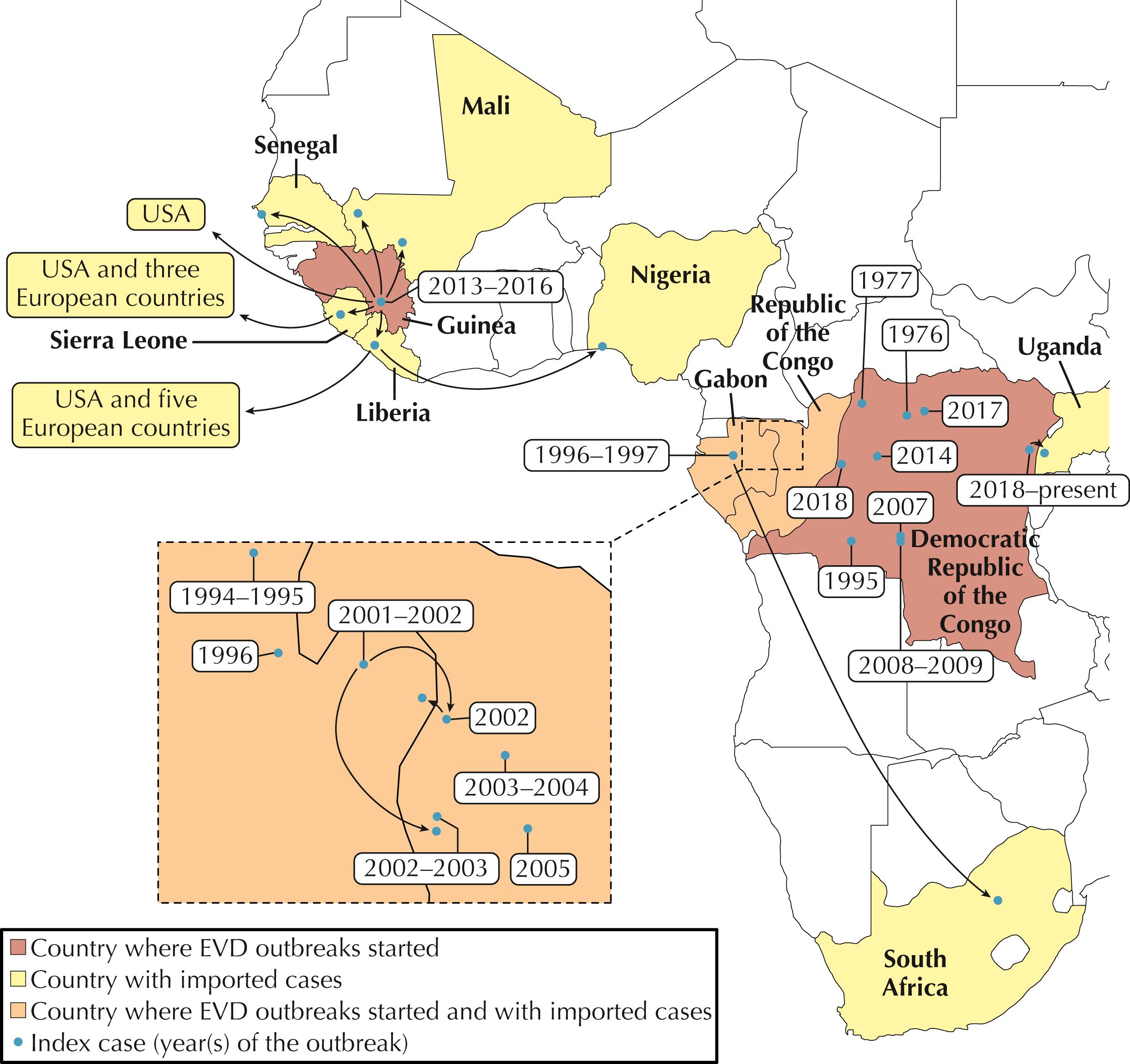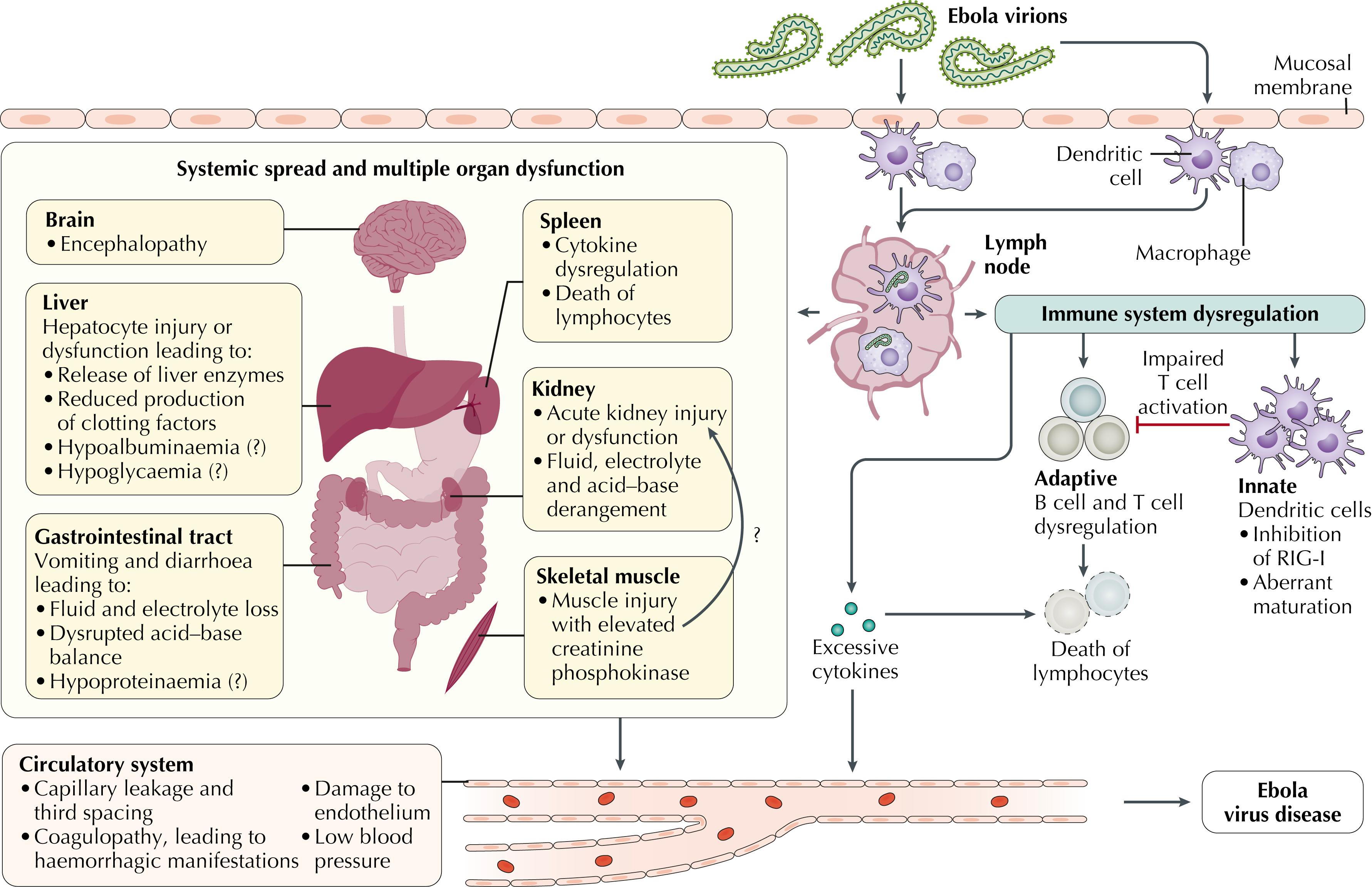Physical Address
304 North Cardinal St.
Dorchester Center, MA 02124
A man in his 50s presented to a facility managing patients infected with Ebola virus disease in Guinea. He had abdominal distension, was slow to speak, and had a mildly ataxic gait. Three weeks earlier he had participated in a family funeral, and several members of that funeral party had been admitted to the unit. He denied symptoms and reported that he, being the family patriarch, had been pressured to come for assessment by younger members of the family. He was initially placed in the “suspected cases” area with other patients who described not having symptoms; however, his blood test proved positive for Ebola Zaire virus. He was therefore moved to the “confirmed cases” area. On requestioning, he reported that he had had a fever and diarrhea for 5 days. On closer physical examination, the patient had some mild skin tenting. He was not tachycardic. He was counseled on using an oral rehydration solution (ORS), assisted in its preparation, and coached to consume at least 4 L of it. The next morning, the patient reported that he had consumed 10 L of ORS. He was more alert, the skin tenting was absent, and his gait had normalized. His subsequent clinical course included waxing and waning symptoms, but he was discharged without severe complications approximately 2 weeks later.
COMMENT: This patient’s experience highlights the challenge of trust in receiving individuals into isolation care, hesitancy in patient disclosures, and how that sometimes impacts infection prevention and control as well as therapeutic elections; impacts of noncommunicable diseases and atypical presentations of illness; the potential of low-resource medical interventions; and how the most important person in a care situation is the patient.
The term Ebola virus disease most commonly refers to infection with Ebola Zaire virus (EBOV), the causative agent of the 2014–2016 West Africa Ebola virus disease epidemic, as well as several recent epidemics in the Democratic Republic of Congo. EBOV is one of several filoviruses, a diverse group of single-stranded negative-sense RNA viruses with a prominent linear component that, on electron microscopy, resembles a filament. Three other species of Ebolavirus —Sudan virus, Taï Forest virus, and Bundibugyo virus—have caused limited human outbreaks. Despite over 40 years of health emergencies resulting from the spread of Ebola viruses among humans, how the human chain of infections begins remains a matter of debate. In general, an initial zoonotic crossover event occurs; bats are thought to be involved either directly or indirectly via bats infecting livestock, or bushmeat (wild animals including primates) that are subsequently consumed by humans. Outbreaks increase in size by human-to-human transmission. This may occur explosively through contact with blood from a terminal patient who has bled, participation in burial rituals in which body washing is conducted, or exposure during healthcare delivery. In sustained outbreaks, the most common mode of human transmission is probably fecal-oral.
Since Belgian missionaries first identified an Ebola outbreak in Congo in 1976, the main burden of disease has been in Central Africa and, more recently, in West Africa. The 2014–2016 West Africa experience involved both the repatriation of international deployers to North America and Europe for care as well as some travel-associated outbreaks in those areas. There have been cases of laboratory-associated disease as well. As in the case of many emerging infectious diseases, communities with little infrastructure or healthcare services are the worst affected. Adding to that burden, stressed, resource-poor health systems suffer disproportionately from cases of nosocomial infection ( Fig. 94.1 ). Sometimes a particular community practice is implicated in large transmission events. The most common association is with burial practices, when mourners from a broad geographic area may congregate and partake of ritual washings of a deceased.

An outbreak of Ebola virus disease (EVD) may have striking impacts on health and wellness for communities that experience even a few cases. It is a disease with high mortality that engenders fear of both the consequences of the disease as well as the measures authorities may take to control it. Healthcare workers associated with early cases may be among the waves of secondary and tertiary infection from a sentinel case. This can have a compounding impact on both the availability of health services and a community’s willingness to engage them. Downstream effects of this have included worse outcomes for the control of other diseases in the community where presentation for care or access to public health programming is important (e.g., HIV, tuberculosis, and malaria management; vaccine and antihelminth programming; and the management of noncommunicable disease).
Other than being in an area endemic for or experiencing an Ebola virus disease outbreak, risk factors for becoming infected are controversial. It seems prudent to avoid exploration of bat habitats as well as involvement in butchering bushmeat. However, once an outbreak is under way, activities such as caregiving for those who are ill, participating in traditional burial practices, having other close contact with ill or deceased persons, or even having repeated casual contact (as experienced among motorcycle taxi operators in Sierra Leone in 2014) all place persons at increased risk.
Occasionally a patient will present without fever and with nonspecific symptoms until later in the course of an illness. However, most patients experience an influenza-like illness before showing a febrile gastroenteritis that can be profound, sometimes with cholera-like volume loss of 4 to 10 L/day. Older patients with comorbidities may separately or concomitantly present with primary neurologic symptoms resembling an encephalitis. These patients have very high case fatality rates. Some patients present with a febrile arthralgia reminiscent of children recovering from meningococcal disease while having little mortality, as this syndrome may be associated with the immune response. Although it is called a viral hemorrhagic fever (VHF) and some bleeding may occur relatively early in the illness, most patients show no signs of hemorrhage or do so when they are experiencing fulminant disease just before death. Occasionally patients manifest a fine papular rash. Hiccups are common among those who are volume depleted. Secondary bacterial infection is a concern over the course of illness, as is concomitant or supervening malaria in endemic areas. Patients may manifest profound visceral pain, particularly in the mediastinal and epigastric areas ( Fig. 94.2 ).

Become a Clinical Tree membership for Full access and enjoy Unlimited articles
If you are a member. Log in here